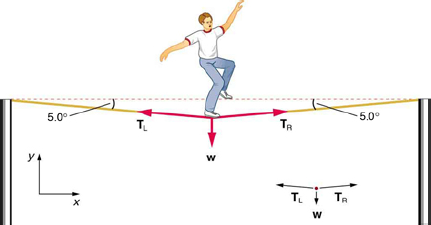Christopher B. answered • 09/15/21
Experienced Physics Teacher/Tutor with Engineering Background
a) For the spider to be motionless, its acceleration = 0. Therefore, the sum of all forces acting on it must add up to 0. In this situation, the only forces we know about are 1) gravity and 2) tension in the string, so they must be equal and opposite.
So, T = mg = (6.00 ✕ 10-5 kg) * (9.81 m/s2) = 5.87*10-4 N
b) Similar idea, but you can think of this tension as spread out between the 2 sides of the strand, like in the picture of the tightrope walker. So, each side of the strand must provide an upward force of half of our answer to a, which comes out to 2.94*10-4 N. But we're not done, because these are not vertical strands - they're at an 11-degree angle. The bigger the angle, the closer we get to that 2.94*10-4 N tension, and the smaller the angle, the bigger the tension gets (so like you'd need a really TIGHT rope for it to not sag). An angle in a given problem is almost always gonna lead us to some trigonometry:
Try drawing a right triangle to represent the strand's position, using an 11-degree angle towards the center. The vertical side (opposite the angle) will represent the vertical component of the tension, which we just solved for. The horizontal (adjacent) side will represent the horizontal component, and the hypotenuse will represent the true overall tension in the strand. Now just use your basic trig rules to solve for the hypotenuse:
sin(Θ) = opp/hyp
sin (11) = 2.94*10-5 N / T
0.1908 * T = 2.94*10-5 N <== I cross-multiplied
T = 1.54*10-3 N
The last part should be simple now - just plug in.
Ratio = (tension in horizontal strand)⁄(tension in vertical strand) = 1.54*10-3 N / 5.87*10-4 N
Ratio = 2.62
This should make sense that it's higher -- the best way to support a vertical downward force is with a vertical upward force. Think about how much easier it is to hold up something heavy like a dumbbell with you arm hanging to your side compared to when your arm is straight out in front of you.






